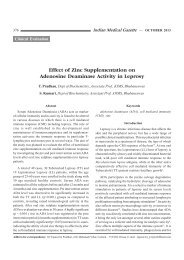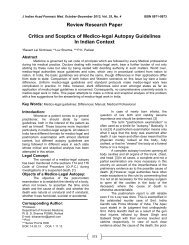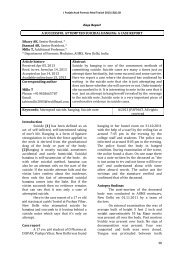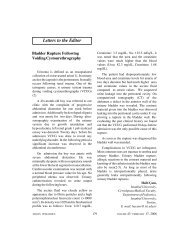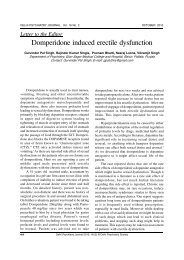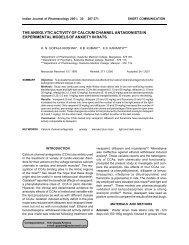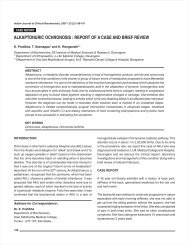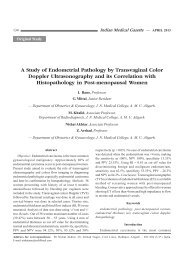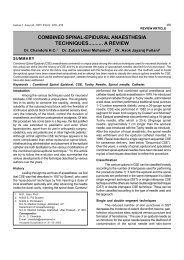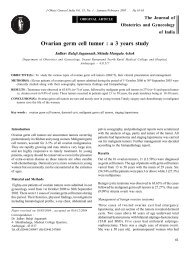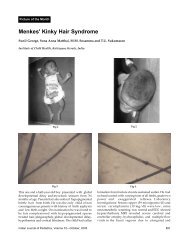Create successful ePaper yourself
Turn your PDF publications into a flip-book with our unique Google optimized e-Paper software.
leg should be positioned in such a way that the knee is<br />
straight or slightly flexed and the thigh externally rotated.<br />
It is important to distract the patient with conversation after<br />
warning him that the sole of the foot will be scratched. It is<br />
advisable to hold the patient’s ankle with one hand, to keep<br />
the foot in place and control the pressure of the plantar<br />
stroke. The stimulus should be firm, gentle and should cause<br />
neither pain nor tickle. A sharp stimulus is applied only if<br />
the initial stimulus fails to elicit a response. The response<br />
can be reinforced by rotation of the patient’s head to the<br />
opposite side. Following the stimulus, it is important to<br />
watch the big toe at the metatarsophalangeal joint and the<br />
remainder of the foot. The response usually occurs after<br />
the plantar stroke has moved a few centimeters along the<br />
sole to produce a spatial and temporal summation of the<br />
applied stimulus.<br />
Interpretation of the response<br />
The plantar response may be:<br />
1. Normal flexor plantar response<br />
2. Pathologic or abnormal extensor plantar response<br />
(Babinski’s sign)<br />
Normal flexor plantar response<br />
In normal people after infancy, there is a plantar flexion of<br />
the foot and toes along with adduction of the toes. The<br />
primary movement is a plantar flexion of the great toe at<br />
the metatarsophalangeal joint, even if the terminal joint<br />
appears to extend. The response is a fairly rapid one and<br />
may be accompanied at times by an associated flexion of<br />
the hip and knee on the stimulated side.<br />
Abnormal extensor plantar response<br />
(Babinski’s sign)<br />
Joseph Babinski, a French neurologist, first differentiated<br />
between a normal and a pathologic plantar response and<br />
described the Babinski sign in 1896. The Babinski’s sign is<br />
encountered in patients with pyramidal tract dysfunction<br />
and is characterised by a dorsiflexion or extension of the<br />
great toe with or without fanning or abduction of the<br />
other toes. The fully developed response is also<br />
accompanied by dorsiflexion of the ankle and flexion of<br />
the hip and knee joint and slight abduction of the thigh,<br />
leading to a withdrawal of the leg on plantar stimulation.<br />
The Babinski sign is always pathological. There is no such<br />
thing as a negative Babinski sign.<br />
The muscles taking part in a fully developed response<br />
include the extensor hallucis longus, tibialis anterior,<br />
extensor digitorum longus, hamstring group of muscles,<br />
and the tensor fasciae latae. The dorsiflexion of the toes<br />
may be the only visible effect, but the contraction of the<br />
thigh and leg muscles is always present and can be<br />
detected by palpation. Contraction of the tensor fasciae<br />
latae has been referred to as Brissaud’s reflex.<br />
The fully developed extensor plantar response forms part<br />
of the primitive ‘flexion reflex synergy’ of the lower limbs<br />
designed to withdraw the limb from a painful stimulus.<br />
This spinal defence reflex mechanism described by<br />
Sherrington, activates all the muscles involved in<br />
shortening the stimulated limb. It involves flexion of the<br />
hip and knee, dorsiflexion of the ankle and extension of<br />
the great toe. The ‘toe and foot extensors’ although named<br />
extensors by anatomists, are in fact flexor in a physiological<br />
sense, because their action is to shorten the limb and<br />
contract reflexly alongwith other flexor muscles. The<br />
physiologist looks on the Babinski sign as simply a part of<br />
the ‘primitive flexion reflex’.<br />
The Babinski sign may be a normal occurrence in the first<br />
year of life. In the infant, before myelination of the nervous<br />
system is complete and an upright stance has been<br />
achieved, the normal plantar response is extensor, due to a<br />
brisker ‘flexion synergy’ as part of the withdrawal response<br />
to pain. As the nervous system matures and the pyramidal<br />
tracts gain more control over spinal motor neurons, the<br />
‘flexion synergy’ becomes less brisk and the toe ‘extensors’<br />
are no longer a part of it. When the child assumes an upright<br />
posture, the plantar response becomes part of the postural<br />
reflex maintaining the tones of the foot and leg. At this time,<br />
the normal response to stimulation becomes a flexor<br />
movement of the toes and the ‘withdrawal extensor’<br />
movement is suppressed by the influence of the pyramidal<br />
tract over the spinal reflex arc. The toe then goes down<br />
instead of up, as a result of a segmental reflex involving<br />
small foot muscles and the overlying skin.<br />
The pyramidal tract thus maintains a suppressor action<br />
on the ‘flexion reflex’ synergy. Pyramidal tract dysfunction<br />
however, allows the response to revert to the primitive<br />
194 Journal, Indian Academy of Clinical Medicine Vol. 6, No. 3 July-September, 2005



